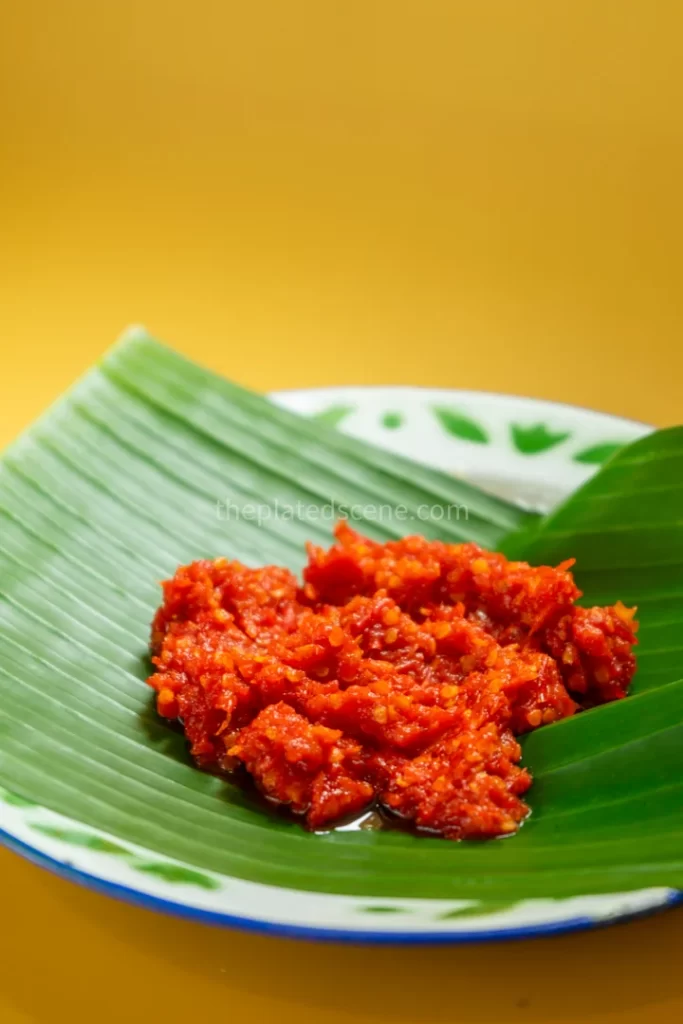Indonesian sambal is more than just a spicy chili paste—it’s a culinary icon embodying the essence of Indonesia’s vibrant food culture. Renowned for its bold and layered flavors, sambal plays a starring role in the Indonesian dining experience. It’s a staple on almost every archipelago table, from humble street food stalls to elaborate family feasts. At its core, sambal is a celebration of fresh, local ingredients painstakingly combined to create a condiment that’s as versatile as it is flavorful.
Table of Contents
Among the many types of Indonesian sambal, Sambal Goreng stands out for its rich and complex flavor profile. With its perfect balance of heat, sweetness, and tanginess, Sambal Goreng is not just a condiment but a transformative element that elevates any meal. Whether paired with steamed rice, grilled chicken, fried fish, or even as a snack dip, its adaptability and robust flavor make it a favorite in households across Indonesia.
The Cultural Significance of Indonesian Sambal
Sambal is deeply intertwined with Indonesia’s cultural identity and culinary traditions. It’s said that no Indonesian meal is complete without sambal, as its presence signifies the bold and adventurous spirit of the cuisine. The word “sambal” originates from the Javanese term sambel, meaning a mixture of crushed chili and other seasonings. Over generations, sambal has evolved into countless variations, each influenced by local ingredients, climate, and cultural preferences.
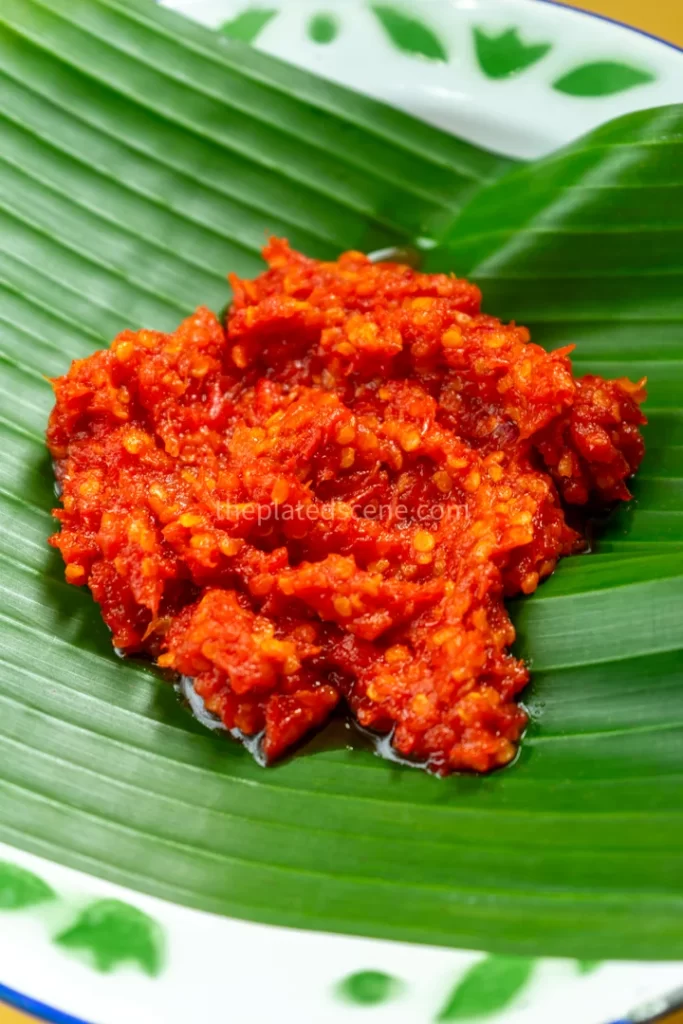
Sambal Goreng, for instance, reflects the harmonious blend of traditional Indonesian cooking techniques and the use of fresh, aromatic ingredients. This sambal type is distinct in its preparation, requiring the ingredients to be fried to enhance their flavors and create a depth that is hard to replicate with raw ingredients alone. The frying process adds a rich, smoky undertone, making Sambal Goreng a stand-out option among the many sambal varieties.
Why Indonesian Sambal Is Beloved Worldwide
The love for Indonesian sambal has transcended borders, making it a sought-after condiment worldwide. Food enthusiasts and chefs from different countries appreciate its ability to add complexity and excitement to dishes. Sambal Goreng, in particular, has become a favorite among those seeking a balanced blend of spiciness and sweetness. With the growing popularity of Indonesian cuisine on the global stage, sambal is now celebrated as a key ambassador of the country’s rich culinary heritage.
But what truly sets sambal apart is its diversity. No two types of sambal are the same, and each offers a unique taste experience. From the fresh and zesty Sambal Matah of Bali to the bold and pungent Sambal Terasi made with shrimp paste, there is a sambal for every palate. Sambal Goreng, however, holds a special place for its versatility and ability to complement a wide variety of dishes.
Why You Should Make Sambal Goreng at Home
While store-bought sambals are convenient, there’s nothing quite like the flavor of homemade sambals. Making Sambal Goreng at home allows you to connect with the heart of Indonesian cooking. It’s a sensory experience—from selecting the freshest chilies and aromatic shallots to frying the ingredients and savoring the rich, spicy aroma that fills your kitchen. Here’s why it’s worth the effort:
- Customization
One of the most significant advantages of making Sambal Goreng at home is the ability to customize the recipe. Adjust the spiciness to your liking, experiment with the level of sweetness, or add a touch of tanginess to make it uniquely yours. - Freshness
Homemade sambal is undeniably fresher and more vibrant than store-bought versions. You can taste the difference in the quality of the ingredients and the care put into its preparation. - Preservative-Free
Many commercial sambals contain preservatives, artificial flavorings, or excessive salt. By making your own, you can enjoy a pure, natural product that’s free of unnecessary additives. - A Taste of Tradition
Crafting sambal from scratch gives you a deeper appreciation for Indonesian culinary traditions. It’s a meaningful way to connect with the culture, even far from the archipelago. - Versatility in Cooking
Sambal Goreng isn’t just a condiment—it’s a multipurpose flavor enhancer. Use it as a base for stir-fries, a marinade for meats, a topping for noodles, or even a spread for sandwiches. Its versatility knows no bounds.
How to Perfect Your Sambal Goreng
Creating the perfect Sambal Goreng requires attention to detail and high-quality ingredients. In the sections ahead, we’ll cover:
- The essential ingredients and their roles.
- Step-by-step instructions for preparing Sambal Goreng.
- Tips for storing and using sambal to maximize flavor.
Prepare to embark on a flavorful journey as you master the art of making Indonesian Sambal Goreng, one of the most beloved condiments in Indonesian cuisine.
Essential Ingredients for Making Indonesian Sambal: Elevate Your Chili Paste Game
Indonesian sambal is a cornerstone of Indonesian cuisine, celebrated for its fiery kick and bold flavors. To craft an authentic sambal that captures the essence of Indonesia, you need high-quality ingredients and attention to detail. While the recipe for Sambal Goreng revolves around just three main ingredients, each one plays a vital role in creating the balance of heat, sweetness, and tanginess that makes this chili paste so iconic.
Three Star Ingredients for Indonesian Sambal
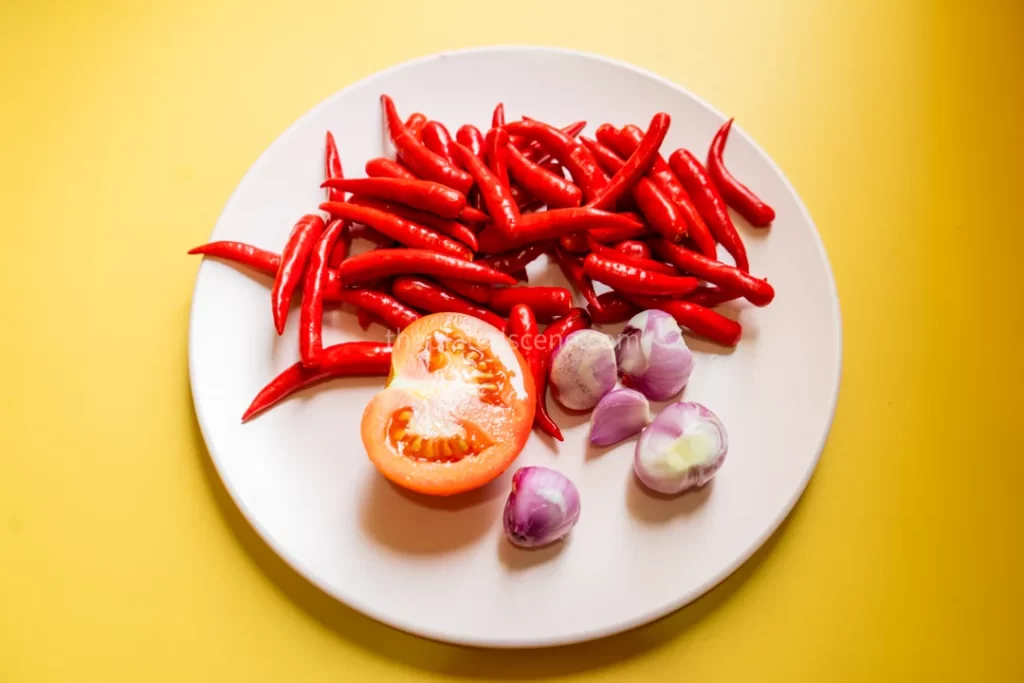
1. Chilies: The Fiery Heart of Indonesian Sambal
Chilies are the backbone of any sambal recipe, and their type and quality significantly influence the flavor and heat of your sambal. In Indonesia, the preferred chili for making sambal is cabe rawit merah (red bird’s eye chili). These tiny chilies pack an intense heat and a fruity flavor that makes Indonesian sambal distinctive.
- What to Use If You Can’t Find Indonesian Chilies:
If cabe rawit merah is unavailable, as is often the case outside Indonesia, don’t worry! In Singapore or other places, you can use locally available red chilies like Thai bird’s eye or even larger red chilies for a milder sambal. Thai chilies provide a similar heat level, while larger red chilies can be blended with bird’s eye chilies to achieve a balanced spiciness.
- Tips for Handling Chilies:
When working with chilies, wearing gloves if you have sensitive skin is essential to avoid irritation. Removing the seeds can slightly reduce the heat, but for authentic Indonesian sambal, keeping the seeds intact preserves the fiery kick.
2. Shallots: The Flavor Enhancer
Shallots are the unsung heroes of Indonesian sambal, adding a sweet, aromatic depth to the chili paste. Their natural sweetness complements the heat of the chilies, creating a well-rounded flavor profile.
- Shallot-to-Chili Ratio:
For the perfect balance, I recommend using a ratio of one-part shallots to three-part chilies. However, if you prefer a sweeter sambal, feel free to slightly increase the amount of shallots.
- Preparing Shallots for Sambal:
Slice the shallots thinly before frying. This step ensures that the inner layers cook evenly, producing a rich, caramelized flavor that enhances your sambal. Fresh shallots are crucial; avoid pre-cut or frozen shallots, as they lack the same aromatic intensity.
3. Tomatoes: The Tangy Balancer
Tomatoes bring subtle acidity and sweetness to the sambal, balancing the chilies’ intense heat and the shallots’ richness. The type of tomato you choose can slightly alter your sambal’s final flavor and texture.
- Cherry Tomatoes vs. Regular Tomatoes:
Cherry tomatoes are ideal for their natural sweetness and vibrant flavor, making them an excellent choice for sambal. They’re also easier to measure and work with due to their small size. On the other hand, regular red tomatoes are just as effective and may offer a milder tanginess. If using large tomatoes, cut them into smaller pieces to ensure even cooking.
- Adjusting the Heat with Tomatoes:
For a milder sambal, increase the tomato-to-chili ratio. Adding more tomatoes softens the heat and adds a silky texture and additional depth to the sambal.
Supporting Ingredients for Indonesian Sambal
While chilies, shallots, and tomatoes are the stars, a few supporting ingredients are essential for bringing the sambal together:
- Salt: Enhances the overall flavor and brings out the natural sweetness of the ingredients.
- Sugar: A touch balances the heat and acidity, creating a harmonious taste. Palm sugar is ideal for an authentic Indonesian flavor, but regular sugar is a substitute.
- Vegetable or Mushroom Stock Powder: Adds umami depth to the sambal. This ingredient is optional but recommended for a richer taste.
- Vegetable Oil: Essential for frying the ingredients, oil cooks the aromatics and helps preserve the sambal when stored.
Essential Tools for Making Indonesian Sambal
Creating the perfect sambal isn’t just about the ingredients—it’s also about having the right tools. Here are the essentials:
- Non-Stick Pan: The Frying Essential
A good-quality non-stick pan is crucial for frying the chilies, shallots, and tomatoes. I use a ceramic pan (here is the link to Amazon), ensuring even cooking and preventing sticking. The frying process is essential for developing the rich, smoky flavor that defines Sambal Goreng.- Tip: Ensure the pan is large enough to allow even frying without overcrowding the ingredients. Overcrowding can lead to steaming instead of frying, which may dilute the flavor.
- Immersion Blender: A Convenient Alternative to Traditional Tools
Traditionally, Indonesian sambal is made using a cobek (mortar and pestle), which gives the sambal a rustic texture and an earthy flavor. While the traditional method is unmatched in authenticity, it can be labor-intensive. For convenience, I use a Braun immersion blender (Amazon link), which produces a smooth and evenly blended sambal in minutes. If you don’t have an immersion blender, a regular blender or food processor works just as well.- Traditional vs. Modern Tools:
If you’re feeling adventurous, try making sambal with a mortar and pestle for a more traditional experience. The effort pays off with a unique texture and flavor.
- Traditional vs. Modern Tools:
- Stove: The Core of Cooking Sambal
A reliable stove is, of course, non-negotiable. Medium heat is ideal for frying the ingredients, as it prevents burning and melts the flavors together beautifully.
Optional Enhancements for Your Sambal Recipe
To elevate your Sambal Goreng further, consider these optional ingredients and variations:
- Shrimp Paste (Terasi): Add a small piece of shrimp paste to the frying pan for an authentic umami kick. Roast it lightly before blending for a smoky, pungent depth of flavor.
- Lime Juice: A squeeze of fresh lime juice at the end brightens the sambal, adding a zesty finish.
- Kaffir Lime Leaves: Fry a few leaves with the chilies for an aromatic twist that pairs beautifully with grilled fish or chicken.
Step-by-Step Guide to Making Authentic Indonesian Sambal (Chili Paste)
Creating Indonesian sambal is an art that combines traditional techniques with simple, fresh ingredients. Each step contributes to developing sambal’s signature bold, layered flavors. Follow this detailed guide to make Sambal Goreng, a rich and versatile chili paste staple of Indonesian cuisine.
Step 1: Frying the Main Ingredients
Start by preparing the foundational flavors of your Indonesian sambal: chilies, shallots, and tomatoes. Heat 2-3 tablespoons of vegetable oil in a non-stick pan over medium heat. Add the following ingredients:
- Fresh red chilies: Trim the stems and use them whole or halved, depending on size. Leave the seeds intact for more heat, or remove them for a milder sambal.
- Shallots: Peel and slice them to ensure even cooking.
- Tomatoes: Use halved cherry tomatoes or chunks of large red tomatoes for consistency.
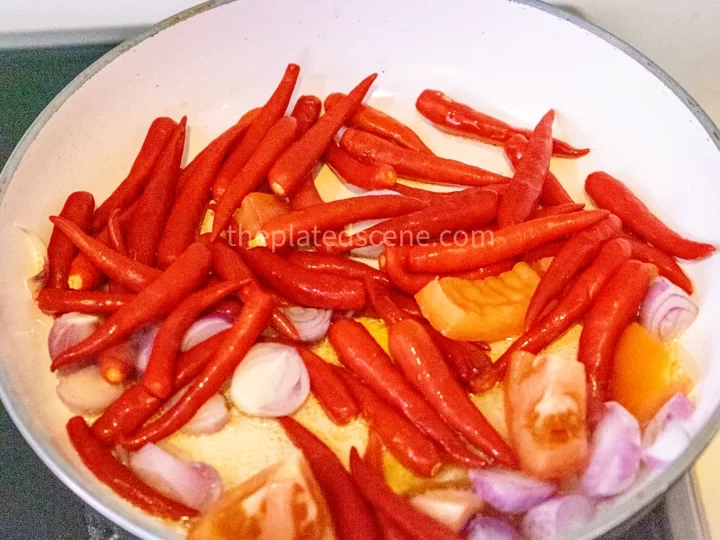
Stir occasionally to evenly fry the ingredients, ensuring they soften without burning. The chilies should blister slightly, releasing their natural oils. The shallots will turn golden and translucent, and the tomatoes will begin to break down, adding a rich, tangy base to your sambal.
Pro Tip: Frying the ingredients enhances their natural sweetness and aroma and reduces the raw sharpness of chilies, making the sambal smoother and more flavorful.
Step 2: Covering the Pan to Trap Moisture
Cover the pan with a lid to allow steam to build up. This step is crucial for cooking the ingredients thoroughly and evenly without drying them out. The steam softens the chilies and tomatoes, breaking them down into a consistency that’s easier to blend.
Let the ingredients cook for 5-7 minutes over medium heat. Check occasionally to ensure they’re not sticking or burning. The moisture retained during this process will also help the ingredients meld together, creating a harmonious base for your Indonesian sambal.

Why This Matters: Steaming the ingredients while frying ensures that the chilies and tomatoes become tender and their flavors concentrate, this step prevents the final sambal from having a raw or unbalanced taste.
Step 3: Stirring and Checking for Doneness
After steaming, remove the lid and stir the mixture. Look for the following signs to confirm the ingredients are perfectly cooked:
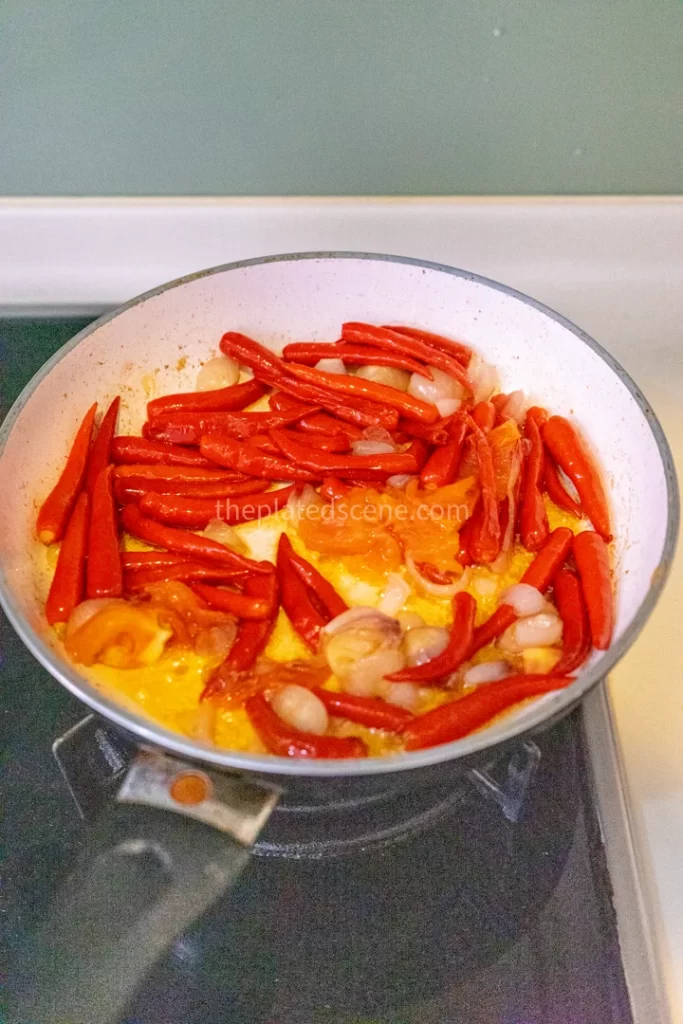
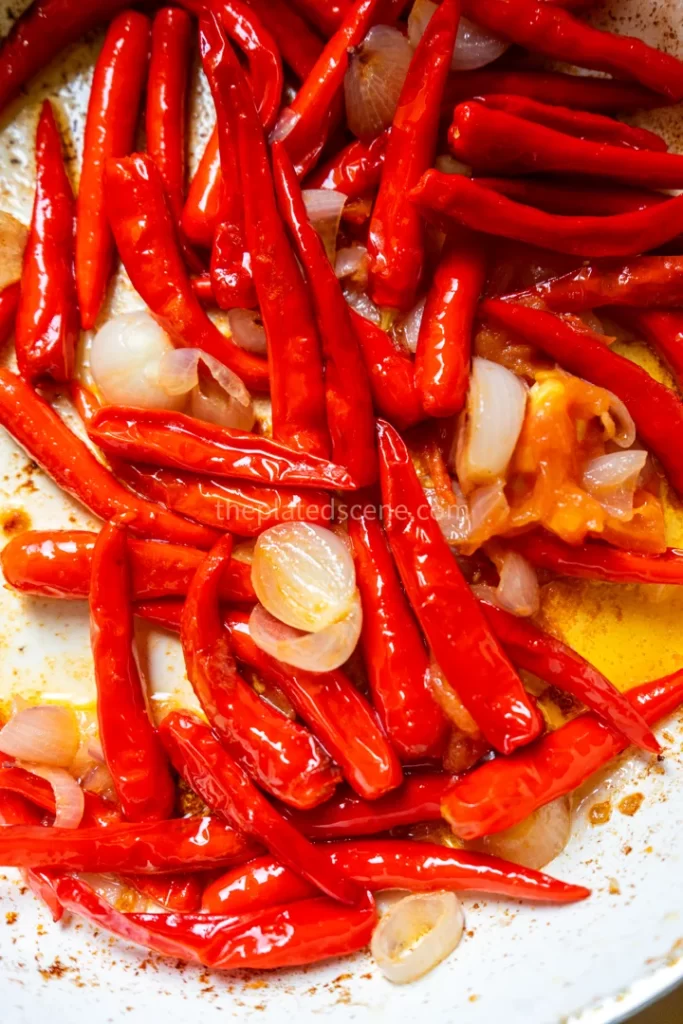
- The chilies should be soft, slightly wilted, and easy to pierce with a fork.
- The shallots should have a golden-brown hue, indicating they’ve caramelized slightly.
- The tomatoes should appear mushy, their skins peeling away and their flesh well-integrated.
Once the ingredients have reached this stage, turn off the heat and let the mixture cool slightly before moving to the next step. Cooling prevents the blender or food processor from overheating and ensures handling safety.
Step 4: Blending the Ingredients
Carefully transfer the cooked ingredients into a blending container or a food processor. Don’t discard the oil left in the pan—this oil is infused with the flavors of the chilies, shallots, and tomatoes and should be added to the mixture for maximum taste.
To the blending container, add:
- Salt: Enhances the natural flavors and balances the heat.
- Sugar or palm sugar: Adds a touch of sweetness to balance the spiciness.
- Mushroom stock powder (optional): Introduces an umami depth for a richer sambal.
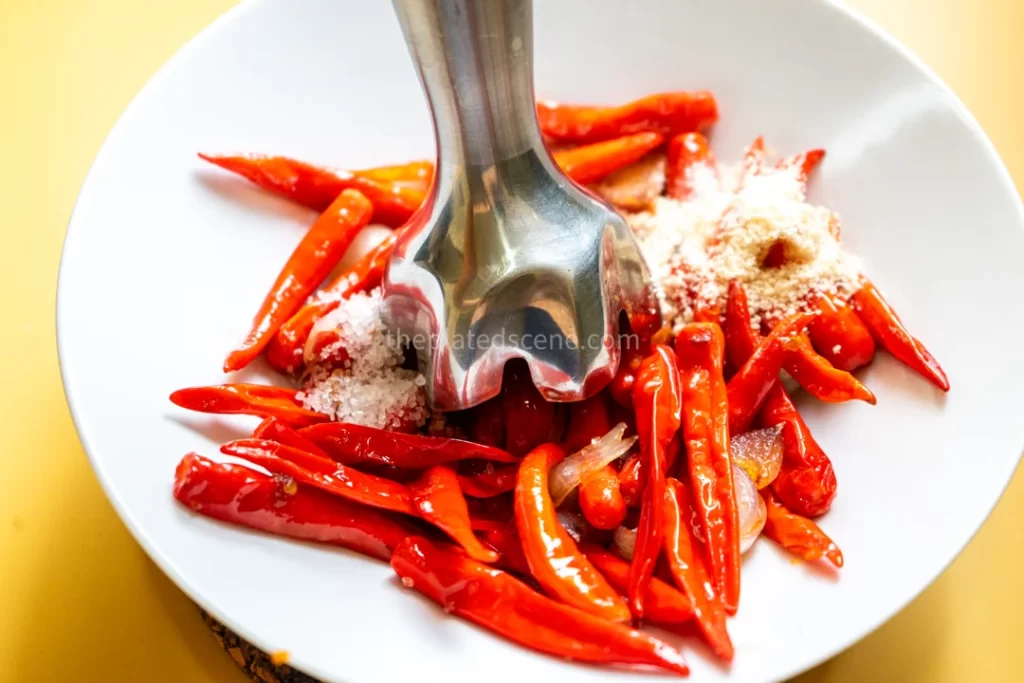

Use an immersion blender, food processor, or regular blender to process the mixture. The texture of your Indonesian sambal depends on your preference:
- For a smooth sambal, blend the mixture until it becomes a fine paste.
- For a rustic, coarser sambal, pulse a few times to retain some texture.
Caution: If blending while the ingredients are still warm, avoid overfilling the container and keep the lid slightly ajar to release steam. This prevents pressure buildup, which can be dangerous.
Step 5: Frying the Sambal Again (Second Fry)
To deepen the flavor and achieve the signature richness of Indonesian sambal, return the blended paste to the pan for a second round of frying. You don’t need to clean the pan beforehand, as any residual flavor from the first fry will enhance the sambal.
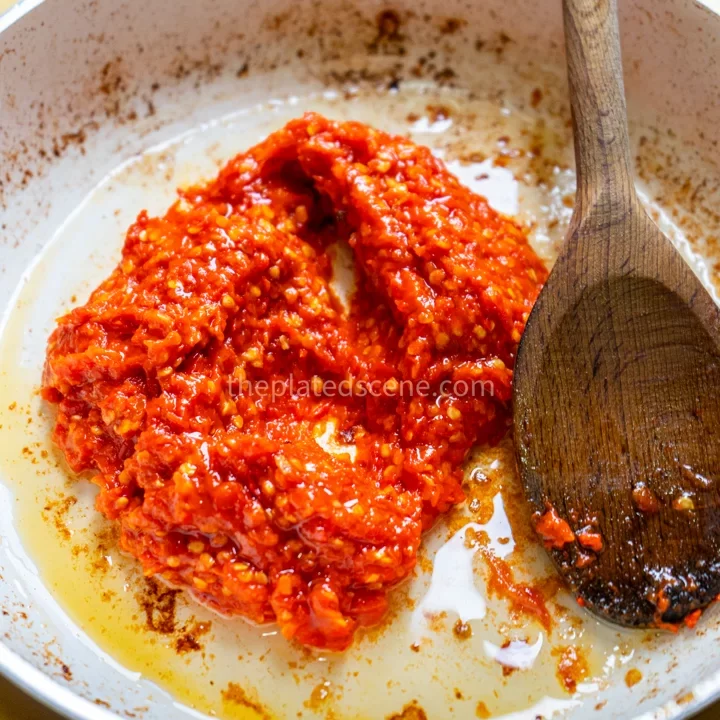
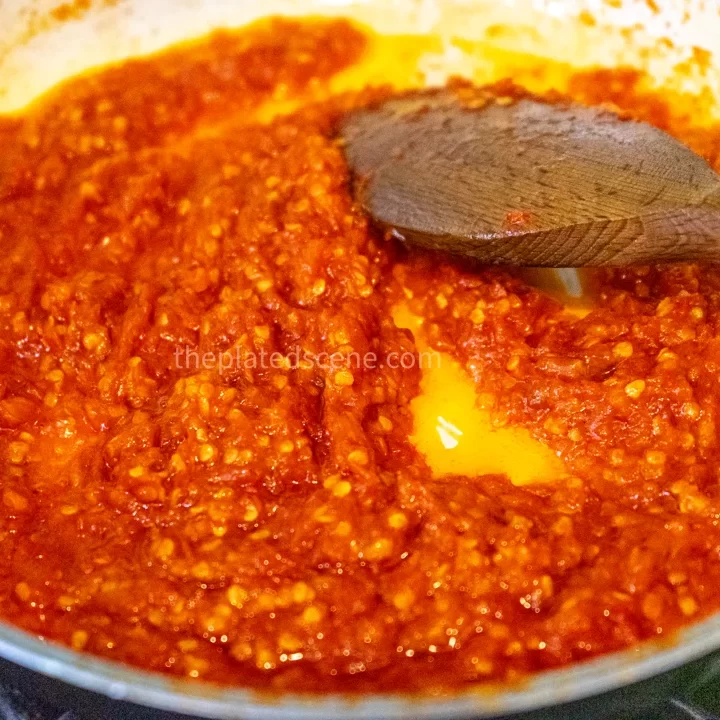
Add a little more oil (about one tablespoon) if necessary, especially if you prefer a sambal with a chili oil consistency. Heat the pan over medium heat and add the blended mixture. Stir continuously to prevent sticking and ensure even cooking.
What to Watch For:
- The sambal will thicken as moisture evaporates.
- Its color will deepen, turning a rich, dark red.
- The aroma will become more intense and fragrant.
- You’ll notice the oil beginning to separate from the paste—this is a sign that the sambal is ready.
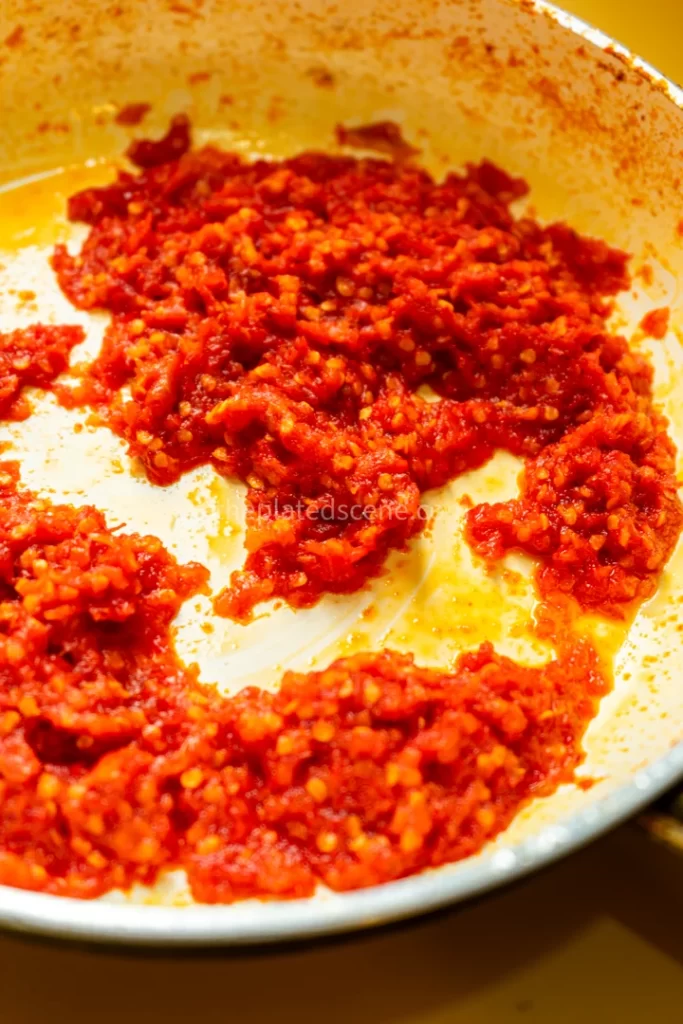
This second fry typically takes 10-15 minutes. The longer you cook the sambal (without burning it), the more concentrated and flavorful it becomes.
Usage Ideas for Indonesian Sambal
Indonesian sambal, particularly Sambal Goreng, is incredibly versatile, making it a must-have condiment for any kitchen. Its bold, spicy flavors can elevate a wide variety of dishes. Here’s how you can incorporate Sambal Goreng into your meals:
1. As a Condiment
Sambal Goreng is a perfect sidekick to numerous Indonesian classics. Its rich, spicy flavor enhances even the simplest dishes. Pair it with:
- Fried Chicken (Ayam Goreng): Add a dollop of sambal to your fried chicken for a fiery kick.
- Fried Tofu (Tahu Goreng): The sambal’s heat pairs wonderfully with crispy tofu.
- Potato Cakes (Perkedel): Dip these golden, savory cakes into Sambal Goreng for a spicy touch.
2. As a Cooking Base
Indonesian sambal isn’t just for dipping or spreading; it also serves as a flavorful base for various dishes. Here are some ideas:
- Sambal Goreng Ikan (Fish with Sambal): Coat fried fish with Sambal Goreng for a bold and flavorful main course. The sambal’s heat and tanginess complement the richness of the fish.
- Sambal Goreng Telur (Eggs with Sambal): Mix the sambal with hard-boiled or fried eggs for a quick, protein-packed dish with a spicy twist.
- Sambal Goreng Tempeh: Stir-fry tempeh with Sambal Goreng for a vegetarian delight full of bold flavors.
3. As a Vegetarian Option
For a vegetarian-friendly Sambal Goreng, omit shrimp paste or substitute it with miso paste to maintain the umami flavor. Use it as:
- A Stir-Fry Sauce: Combine Sambal Goreng with stir-fried vegetables for a nutritious, spicy side dish.
- A Dip: Pair the sambal with fresh or fried tempeh, tofu, or veggie sticks for a wholesome snack.
Tips for Perfecting Your Sambal Goreng
Creating authentic Indonesian sambal takes practice and attention to detail. Here are some tips to ensure success:
- Adjust the Heat:
The spiciness depends on the type and quantity of chilies you use. For a milder sambal, remove the seeds from the chilies before blending. For a fiery sambal, keep the seeds intact and use smaller, spicier chilies like bird’s eye chilies. - Consistency is Key:
The texture of your sambal can vary based on cooking time. Cook longer for a thicker, more concentrated sambal. Stir constantly during the second fry to prevent burning. - Experiment with Ingredients:
Add unique flavors like lemongrass, galangal, or lime juice to your sambal for an aromatic twist. Roasted shrimp paste (terasi) or a splash of coconut milk can also add depth. - Storage Tips:
Always use a clean spoon to avoid contamination when scooping sambal from the jar. Proper handling will help extend its shelf life and maintain its vibrant flavor.
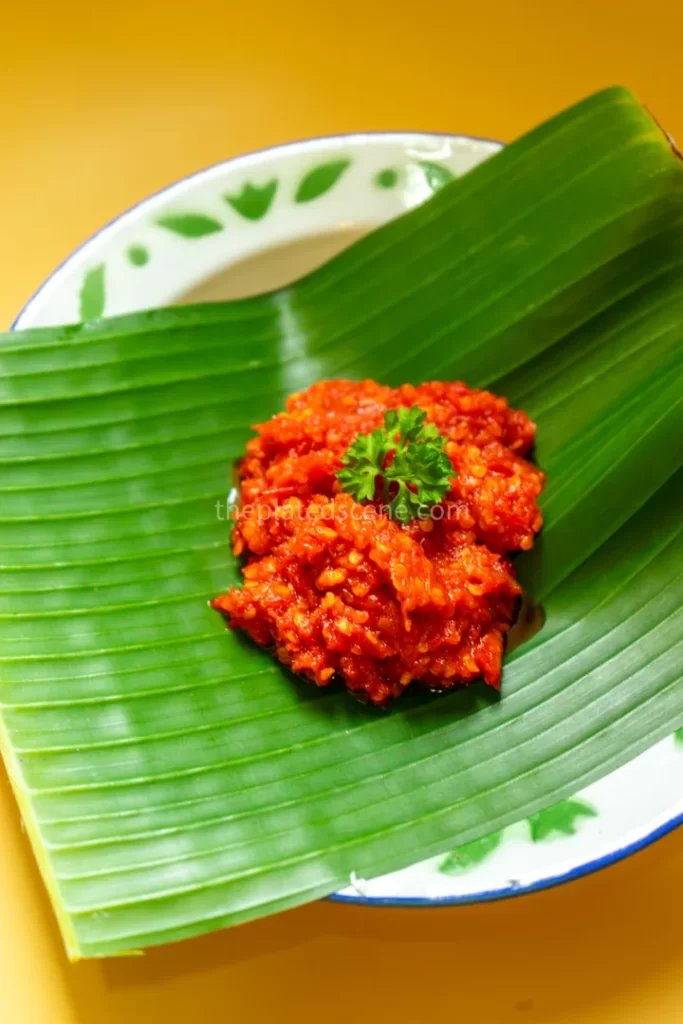
Pairing Sambal Goreng with Other Dishes from My Blog
Sambal Goreng is a versatile and flavorful condiment that elevates countless dishes. Sambal Goreng is the perfect companion whether you’re looking to add heat to your meals or enhance traditional Indonesian recipes. Here are some dishes from my blog that pair beautifully with Sambal Goreng, complete with links to their recipes for a seamless cooking experience:
1. Vegan Chicken Soup
The comforting flavors of vegan chicken soup get a spicy upgrade with Sambal Goreng. Serve it on the side for a customizable heat level or mix it directly into the broth for a fiery twist.
👉 Try my Vegan Chicken Soup recipe.
2. Tahu Tempe Bacem
Sambal Goreng pairs wonderfully with the sweet and savory flavors of Tahu Tempe Bacem. Drizzle it over the marinated tofu and tempeh for a spicy contrast or use it as a dipping sauce to enjoy a balance of flavors in every bite.
👉 Check out my Tahu Tempe Bacem recipe.
3. Gulai Nangka (Jackfruit Curry)
The bold heat of Sambal Goreng perfectly complements the rich, creamy flavors of Gulai Nangka. Serve it as a condiment on the side to add a layer of spice and tang to this hearty jackfruit curry.
👉 Follow my recipe for Gulai Nangka here.
4. Vegan Mushroom Satay
Sambal Goreng makes a fantastic dipping sauce for Vegan Mushroom Satay. The spicy, tangy notes of the sambal enhance the smoky, grilled mushrooms, creating a vibrant and satisfying combination.
👉 Discover my Vegan Mushroom Satay recipe.
5. Sayur Bening Bayam (Clear Spinach Soup)
Add a spoonful of Sambal Goreng to Sayur Bening Bayam for a spicy twist on this light and refreshing soup. The sambal adds warmth and depth to the dish, making it perfect for a chilly day.
👉 Learn how to make Sayur Bening Bayam.
6. Gudeg Yogya (Sweet Jackfruit Stew)
The sweet and savory flavors of Gudeg Yogya are beautifully balanced with the spiciness of Sambal Goreng. Pair them together for an authentic taste of Yogyakarta cuisine that’s rich, complex, and utterly satisfying.
👉 Try my Gudeg Yogya recipe here.
Storing Indonesian Sambal Goreng for Maximum Freshness
Proper storage is essential to maintain the vibrant flavor, aroma, and texture of your Indonesian Sambal Goreng. Whether making a small batch to enjoy over the week or preparing a larger quantity for long-term use, these tips will ensure your sambal stays fresh and delicious.
1. Cooling the Sambal Goreng
After cooking, allow the sambal to cool completely at room temperature. This step is crucial to prevent condensation from forming inside the storage container, which can lead to spoilage. Cooling also helps the sambal settle, intensifying its flavors.
2. Storing in Sterilized Jars
For short-term storage:
- Transfer the cooled Sambal Goreng into a sterilized, airtight glass jar.
- Use a clean spoon or ladle to avoid contamination.
- Press the sambal down to eliminate air pockets, then add a thin layer of oil on top. This oil acts as a natural preservative, sealing the sambal from air exposure and extending its freshness.
- Seal the jar tightly and store it in the refrigerator.
Shelf Life: Sambal Goreng will remain fresh for up to two weeks when refrigerated.
3. Freezing for Long-Term Storage
For longer storage:
- Divide the Sambal Goreng into small portions using an ice cube tray. Each cube can be one serving size, making thaw only what you need easy.
- Once frozen solid, transfer the sambal cubes into a freezer-safe bag or container. Label the bag with the date to keep track of freshness.
- To prevent freezer burn, squeeze out as much air as possible from the bag before sealing.
Shelf Life: Frozen Sambal Goreng can stay fresh for up to three months.
Thawing Tips:
- Remove only the sambal you need and thaw it in the refrigerator or at room temperature.
- Avoid refreezing thawed sambal, as this can alter its texture and flavor.
4. Reheating and Using Sambal Goreng
When you’re ready to use your stored sambal:
- Gently reheat the portion in a small pan over low heat, adding a splash of oil to revive its texture.
- Stir occasionally to ensure even heating without burning.
Reheating warms the sambal and brings back its freshly cooked aroma, making it taste as good as new.
5. Tips for Optimal Storage
- Use Clean Utensils: Always use a clean, dry spoon when scooping sambal from the jar to avoid introducing moisture or bacteria.
- Oil Seal: Regularly check and maintain the thin layer of oil on top of the sambal in the jar for better preservation.
- Small Batches: If you make sambal frequently, store it in smaller portions to minimize handling and exposure.
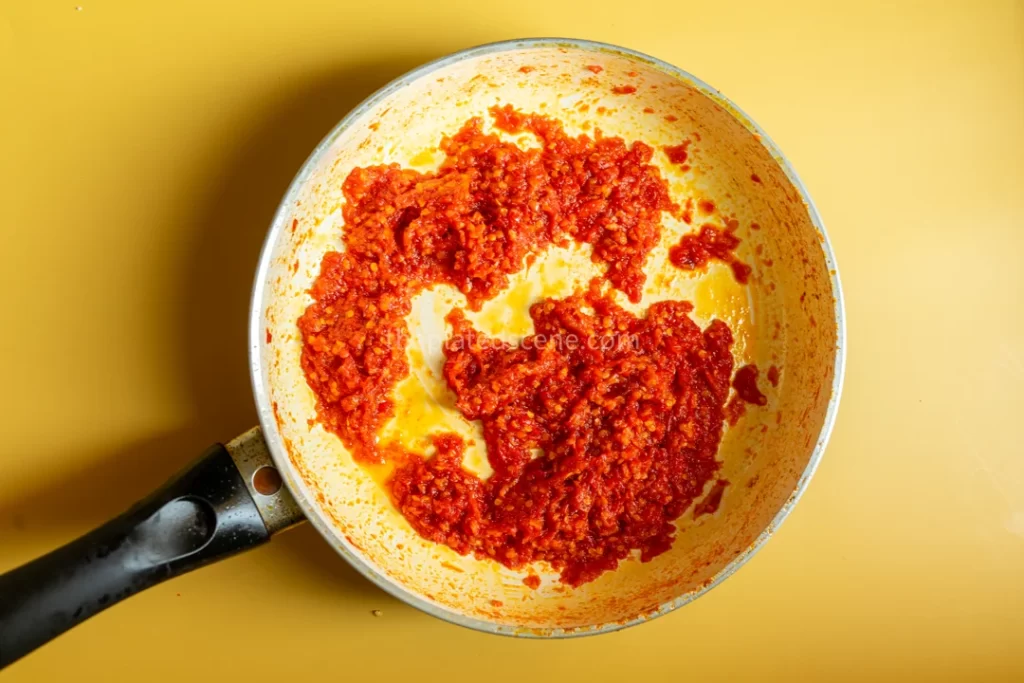
Final Thoughts: Embrace the Bold Flavors of Indonesian Sambal Goreng
Making Indonesian Sambal Goreng at home is more than just cooking—an invitation to explore the vibrant world of Indonesian culinary traditions. Creating this iconic chili paste is rewarding, filling your kitchen with bold aromas and delivering a flavor-packed condiment that will transform your meals.
With its unmatched versatility, Sambal Goreng can become a staple in your kitchen. Use it as a fiery condiment to elevate simple dishes, a rich cooking base for authentic Indonesian recipes, or a spicy dipping sauce to liven up your snacks. No matter how you enjoy it, Sambal Goreng brings the heart of Indonesia to your table.
Ready to spice up your cooking? Start making your own Sambal Goreng today! Dive into the bold flavors of Indonesia and experience the joy of creating this culinary classic.


